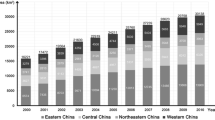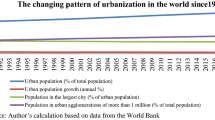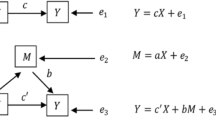Abstract
At the macro-national level, foreign direct investment (FDI) can effectively promote the new urbanization in China. However, at the urban level, the interactions between FDI and the new urbanization are still not clear. To answer this question, this study constructs a new urbanization development index system based on a panel data set of 271 cities in China from 2003 to 2014. The weights of 26 secondary indicators are determined by the entropy method, and the spatial and temporal effects between FDI and the new urbanization are analyzed using the Panel Vector Autoregression model. Furthermore, direct–indirect effects of urbanization and that of FDI are respectively studied from short-term and long-term two visual angel. The results show that the FDI inflow is an exogenous motive force for the new urbanization, and the new urbanization provides strong support for attracting foreign capital. However, FDI in the neighboring areas is not conducive to local urbanization, and the urbanization of the surrounding areas will inhibit the local FDI Inflows.

Similar content being viewed by others
Notes
The Belt and Road Initiative refers to China’s cooperation initiative to build a “New Silk Road Economic Belt” and a “21st Century Maritime Silk Road”. It aims to use the historical symbols of the ancient Silk Road to actively develop economic partnership relationships with the countries along this route.
New urbanization is urbanization with Chinese characteristics. It is characterized by urban–rural integration, industrial interaction, intensiveness, ecological livability, and harmonious development.
China’ s urbanization was in a high-speed development stage before 2003,the urbanization rate increased from 27.46% in 1992 to 40.53% in 2003. The turning point of China’ s urbanization appeared in 2003, the report of 17th National Congress clearly put forward to raise the level of urbanization gradually and persist in the coordinated development of cities along the path to urbanization with Chinese characteristics. Henceforth, China’s urbanization began to pursue high “quality”. Although the concept of “new urbanization” has not been formally proposed at that time, the characteristics of urbanization have changed, which is the important basis and era background for the emergence of “China's new urbanization”. Therefore, the study based on the data from 2003 is in line with Chinese actual conditions.
Because a lot of data for some cities of Xinjiang and Tibet is missing, they have been removed from the sample to ensure the accuracy of this study.
When VAR is applied to the panel data estimation, it is related to the independent variables due to the influence of the dependent variable's lag term, which makes the “mean difference method”, traditionally used to eliminate the fixed effects, biased in estimating the coefficient.
The forward differential Helmert transformation method avoids the orthogonality of the lagging regression term and the differential term of the instrumental variable through removing the forward mean, which makes the measurement test result more accurate.
The Moran’s index ranged from − 1 to 1. If the measured Moran's I is between 0 and 1, there is a positive spatial autocorrelation, which means that the target variable is positive mutual feedback between different regions; if Moran's I is between -1 and 0, the spatial autocorrelation is negative, and the adjacent regions reflect a certain degree of "competition".
Using Wald and LR test methods, it can be determined both whether the spatial Durbin model degenerates into a spatial error model through testing \(\gamma = - \rho \beta\) and whether it degenerates into a spatial lag model through testing \(\gamma = 0\).
References
Behera, S. R., & Dash, D. P. (2017). The effect of urbanization, energy consumption, and foreign direct investment on the carbon dioxide emission in the SSEA (South and Southeast Asian) region. Renewable and Sustainable Energy Reviews, 70, 96–106.
Behname, M. (2013). FDI Localization, wage and urbanization in central Europe. The Romanian Economic Journal, 16, 23–36.
Cao, C., & Duan, J. (2015). Empirical analysis on impact of FDI on the level of urbanization in costal areas. Journal of Industrial Engineering and Management, 8(2), 399–416.
Chen, M., Lu, D., & Zhang, H. (2009). Comprehensive evaluation and the driving factors of China’s urbanization. Acta Geographica Sinica, 64(4), 387–398.
Chen, C., & Wu, Y. (2017). Impact of foreign direct investment and export on urbanization: evidence from China. China & World Economy, 25(1), 71–89.
Cheng, K., & Duan, C. (2010). Correlative mechanism and dynamic econometric analysis between FDI and urbanization in China. Economic Geography, 30(1), 99–103.
Cheng, H., & Yan, S. (2003). Foreign direct investment and economic growth: the importance of institutions and urbanization. Economic Development and Cultural Change, 51(4), 883–896.
Elhorst, J. P. (2012). Dynamic spatial panels: models, methods and inferences. Journal of Geographical System, 14(1), 5–18.
Elhorst, J. P. (2014). Spatial econometrics from cross-sectional data to spatial panel. Berlin: Springer.
Foldi, Z., & Weesep, J. (2006). Impacts of globalization at the neighborhood-level in Budapest. Journal of Housing and the Built Environment, 22, 33–50.
Halvorsen, T. (2012). Size, location and agglomeration of inward foreign direct investment in the United States. Regional Studies, 46(5), 669–682.
Kan, D. X., & Lv, L. J. (2018). An empirical study of the effect of urbanization on FDI. Economic Survey, 35(2), 64–70.
Lin, G. C. S. (2007). Chinese urbanism in question: State, Society and the reproduction of urban spaces. Urban Geography, 28(1), 7–29.
Liu, M., & Liu, Y. (2011). The relationship between the development of China’ urbanization and carbon emissions: An empisical study based on 30 provinces’ data. Urban Studies, 18(11), 27–32.
Lu, M. (1997). Regional distribution of foreign direct investment and China’s investment environment assessment. Economic Research Journal, 12, 37–44.
Peng, J., & Deng, W. (2013). An empirical analysis of the interaction between FDI, urbanization and economic growth: A case study of jiangxi province’s time series from 1984 to 2010. Journal of Finance and Economics, 1, 30–33.
Seto, K. C. (2011). Exploring the dynamics of migration to mega-delta cities in Asia and Africa: Contemporary drivers and future scenarios. Global Environmental Change, 21(4), 94–107.
Shen, J., Wong, K., Chu, K., & Feng, Z. (2000). The spatial dynamics of foreign investment in the pearl river delta, south China. The Geographical Journal, 166(4), 312–322.
Shi, Y., & Gu, M. (2003). Development of urbanization drived by foreign capital in the yangtze river delta. Modern Urban Research, 18(4), 1–7.
Sun, P., & Wu, Li. (2010). Analysis of the impact of foreign direct investment on the urbanization process based on a big driving model. Economist, 11, 66–74.
Wu, L., & Gu, C. (2005). Globalization, foreign investment and urbanization in developing countries: A case study of Jiangsu. Urban Planning, 7, 28–33.
Wu, J. P., & Radbone, I. (2005). Global integration and the intra-urban determinants of foreign direct investment in Shanghai. Cities, 22(4), 275–286.
Yu, Y., Zhang, L., & Zheng, X. (2013). Strategic interaction and the determinants of public health expenditures in China: a spatial panel perspective. The Annals of Regional Science, 50(1), 203–221.
Yuan, D. M., Xin, C. H., & Yu, B. (2017). Does FDI propel the urbanization in China—The threshold effect test from the financial development perspective. Journal of International Trade, 5, 126–138.
Acknowledgements
This study was supported by Huaqiao University’s Academic Project Supported by the Fundamental Research Funds for the Central Universities (Grant No. 16SKGC-QT04).
Author information
Authors and Affiliations
Corresponding author
Additional information
Publisher's Note
Springer Nature remains neutral with regard to jurisdictional claims in published maps and institutional affiliations.
Rights and permissions
About this article
Cite this article
Wu, W., Zhao, K. Dynamic interaction between foreign direct investment and the new urbanization in China. J Hous and the Built Environ 34, 1107–1124 (2019). https://doi.org/10.1007/s10901-019-09666-y
Received:
Accepted:
Published:
Issue Date:
DOI: https://doi.org/10.1007/s10901-019-09666-y




